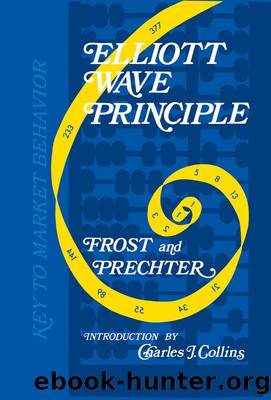Elliott Wave Principle by Frost & Prechter

Author:Frost & Prechter
Language: eng
Format: epub
Published: 2019-03-22T16:52:08+00:00
In Part II of this book, we reverse the editorsâ suggested procedure and argue that economic considerations at best may be thought of as an ancillary tool in checking market forecasts based entirely upon the Elliott Wave Principle.
CHAPTER 4
RATIO ANALYSIS
AND FIBONACCI TIME SEQUENCES
Ratio Analysis
Ratio analysis is the assessment of the proportionate relationship, in time and amplitude, of one wave to another. In discerning the working of the Golden Ratio in the five up and three down movement of the stock market cycle, one might anticipate that on completion of any bull phase, the ensuing correction would be three-fifths of the previous rise in both time and amplitude. Such simplicity is seldom seen. However, the underlying tendency of the market to conform to relationships suggested by the Golden Ratio is always present and helps generate the right look for each wave.
The study of wave amplitude relationships in the stock market can often lead to such startling discoveries that some Elliott wave practitioners have become almost obsessive about its importance. Although Fibonacci time ratios are far less common, years of plotting the averages have convinced the authors that the amplitude (measured either arithmetically or in percentage terms) of virtually every wave is related to the amplitude of an adjacent, alternate and/or component wave by one of the ratios between Fibonacci numbers. However, we shall endeavor to present some evidence and let it stand or fall on its own merit.
The first data reflecting time and amplitude ratios in the stock market come from, of all suitable sources, the works of the great Dow Theorist, Robert Rhea. In 1934, Rhea, in his book The Story of the Averages, compiled a consolidated summary of market data covering nine Dow Theory bull markets and nine bear markets spanning a thirty-six year time period from 1896 to 1932. He had this to say about why he felt it was necessary to present the data despite the fact that no use for it was immediately apparent:
Whether or not [this review of the averages] has contributed anything to the sum total of financial history, I feel certain that the statistical data presented will save other students many months of work.... Consequently, it seemed best to record all the statistical data we had collected rather than merely that portion which appeared to be useful.... The figures presented under this heading probably have little value as a factor in estimating the probable extent of future movements; nevertheless, as a part of a general study of the averages, the treatment is worthy of consideration.
One of the observations was this one:
The footings of the tabulation shown above (considering only the industrial average) show that the nine bull and bear markets covered in this review extended over 13,115 calendar days. Bull markets were in progress 8,143 days, while the remaining 4,972 days were in bear markets. The relationship between these figures tends to show that bear markets run 61.1 percent of the time required for bull periods.
And finally,
Column 1 shows the sum of all primary movements in each bull (or bear) market.
Download
This site does not store any files on its server. We only index and link to content provided by other sites. Please contact the content providers to delete copyright contents if any and email us, we'll remove relevant links or contents immediately.
An MBA in a Book by Xander Cansell(213)
Art of The Strategic Side Hustle: Simple Steps to Developing a Passive Income Side Hustle (The Strategic Series) by Hodge Kimberly(173)
Whole Numbers and Half Truths: What Data Can and Cannot Tell Us About Modern India by Rukmini S(146)
The Art of Building Your Resilience and Adaptability by Néstor Gandara(145)
Playing for Time by Jeremy Lewis(137)
Pragmarketism by Arvind Bhandari(135)
Non-Profit Legends for Humanity and Good Citizenship by Moore Hank;(125)
Corporate Chanakya on Leadership by Radhakrishnan Pillai(124)
Under the Skin of the Indian Consumer by David Abikzir(120)
The Sharesies Guide to Investing by Brooke Roberts & Leighton Roberts and Sonya Williams(117)
Case of the Bonsai Manager by R Gopalakrishnan(115)
Crisis Investing for the Rest of the '90s by Douglas Casey(113)
IEC 61636-2-2023 (IEEE Std 1636.2) by IEC(113)
Fine Printing and Private Presses by Roderick Cave(111)
Aesthetic Labour by Warhurst Chris;Nickson Dennis; & Dennis Nickson(110)
Breakpoints by Mike Ashby(109)
Dream Believe Create by Hayley Lewis(108)
IEC 61136-1-1992 scan by Unknown(105)
SMARTS: Are We Hardwired for Success? by CHUCK MARTIN PEG DAWSON AND RICHARD GUARE(92)
